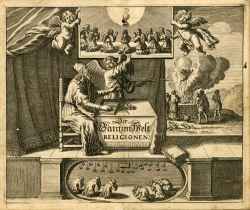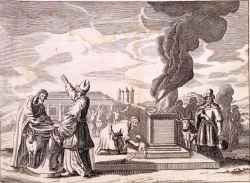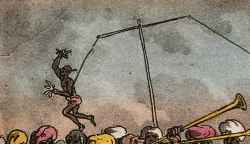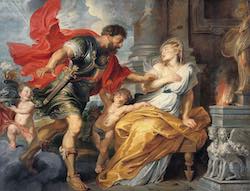Topic: 2. Sacrifice and religion: Comparisons, Antiquarians, Anthropology (16th-18th Century)
Religious sacrifices across various cultures and contexts sparked widespread interest in Early Modern Europe. As Christianity expanded into regions inhabited by "infidels" and "pagans", Europeans encountered a diverse array of sacrificial customs, ranging from the Sati rituals in India to the Aztec sacrifices in the Americas. This cross-cultural exposure captivated a wide audience, including theologians, philosophers, political thinkers, antiquarians, orientalists, missionaries, poets, artists, and even the general public. These encounters broadened the European understanding of sacrifice and led to a critical reassessment of classical and biblical sacrificial rites. This section includes:
- Sources: A selection of early modern printed materials, which include descriptions of the Americas, Asia, and Africa, alongside antiquarian and philological studies on religious sacrifice in classical antiquity and beyond. It also presents early modern works of ethnological observations and the first attempts to compare different sacrificial practices in various traditions and contexts, laying the groundwork for disciplines like the history of religions and anthropology.
- Iconographic Representations: A rich collection of images from the 16th to 18th centuries, illustrating a range of sacrificial rituals and practices as seen in different cultural and geographical contexts.
- Related Bibliography: An extensive bibliography spanning scholarly works from the 19th to 21st centuries, providing contemporary analyses and interpretations of these early studies and observations.
Pansebeia, or, A view of all religions in the world with the severall church-governments from the creation, to these times : also, a discovery of all known heresies in all ages and places, and choice observations and reflections throughout the whole
London: John Saywell , 1644.
Scene of Animal Sacrifice (1668)
from: Der gantzen Welt Religionen oder Beschreibung aller Gottes- und Götzendienste wie auch Ketzereyen in Asia, Africa, America und Europa, Amsterdam, Joach. Nosch, 1668
Scene of idolatrous sacrifice (1668)
from: Der gantzen Welt Religionen oder Beschreibung aller Gottes- und Götzendienste wie auch Ketzereyen in Asia, Africa, America und Europa, Amsterdam, Joach. Nosch, 1668
Sacrifice et transfert des âmes chez les Songhay du Niger
in: Systèmes de Pensée en Afrique Noire, v. 2 (1976), issue : pp.55-66.
Sacrifice in Early Christianity : the Social Dimensions of a Metaphor
in: Sacrifice in Modernity : Community, Ritual, Identity : from Nationalism and Nonviolence to Health Care and Harry Potter, pp. 132-146
Leiden: Brill, 2017.
Ristretto della vita e martirio di S. Simone fanciullo di Trento e fatto ristampare con una breve appendice da d. Francesco Rovira Bonet rettor de' Catecumeni, e parroco di S. Salvatore a' Monti
Roma: Giovanni Bartolomicchi, 1775.
Incapable States: Negotiating Violence and Rights in India
New Delhi: Oxford University Press, 2020.
Mars and Rhea Silvia [1617]
Liechtenstein Museum, Wien
Theology, Ethnography, and the Historicization of Idolatry
in: Journal of the History of Ideas, v. 67 (2000), issue 4: pp.571-596.
Travel and Ethnology in the Renaissance South India through European Eyes, 1250–1625
Cambridge: Cambridge University Press, 2009.
Teatro italiano o sia scelta di tragedie per l'uso della scena. Tomo primo in cui si contengono La Sofonisba del Trisino. L'Oreste del Rucellai non più stampato. L'Edipo di Sofocle tradotto dal Giustiniano. La Merope del Torelli. Premessa un'Istoria del Teatro e difesa di esso
Verona: Jacopo Vallarsi, 1723.
Les mythes grecs relatifs à l'instauration du sacrifice
in: Museum Helveticum, v. 27 (1970), issue 1: pp.1-15.






